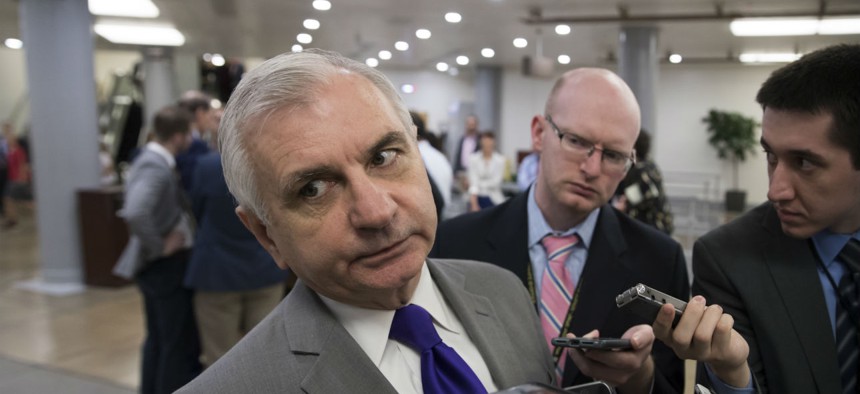Senators Signal Resistance to Proposed Low-Yield Nukes
Several Democratic lawmakers on a key committee are pushing back on the given rationale for a new warhead and cruise missile.
Two of the latest Nuclear Posture Review’s most headline-grabbing proposals — to develop a lower-yield ballistic-missile warhead and a new submarine-launched cruise missile — are running into resistance in a key Senate committee.
Several Democratic senators on the Armed Services Committee, which would have to approve the new weapons’ development, expressed concerns.
The Pentagon says they’re necessary to deter Russia from using its own low-yield nukes to win an otherwise conventional war. The argument goes that the U.S. would then either be forced to escalate with higher-yield missiles, or concede. Ranking member Sen. Jack Reed, D-R.I., , isn’t convinced the solution is more low-yield nukes on the American side.
“While I agree with much of the NPR, I have concerns about the low-yield submarine launched warhead,” he said in opening remarks at an Armed Service Committee hearing Tuesday. “The Russian doctrine of ‘escalate-to-deescalate’ could easily spin out of control if our response to their low-yield weapon is to use a similar one; which could escalate into an exchange of larger weapons.” He reiterated the same point in questions later.
Some Republican senators expressed support for the new weapons. Sen. Jim Inhofe, the Oklahoma Republican chairing the committee in Sen. John McCain’s absence, spent time drawing out the Pentagon’s rationale and downplayed the divergence between the parties as “a little difference of opinion.”
It’s too soon to know what will be in this year’s defense authorization. But the proposal’s likely to remain contentious, said Kingston Reif, a nonproliferation expert at the Arms Control Association.
“What we heard today suggests there’s division on the Armed Services Committee about the need and rationale for this proposal,” Reif said. It’s “an indication that this will be hotly debated. It will be controversial — and it should be.”
And that controversy could have serious implications for nuclear funding. Regardless of how the debate over what nuclear capabilities are necessary shakes out, Reed said it could ultimately “disrupt a bipartisan consensus that presently ensures the modernization of the triad.”
In his 2001 NPR, George W. Bush’s administration proposed new weapons concepts, including variable- and low-yield options.
“Bipartisan majorities in Congress opposed all of those proposals,” Reif said. “They were controversial at the time, members questioning the need and affordability … and I think past is likely to be precedent again in this case, in that the proposals to develop new capabilities that aren’t currently in the stockpile will be the subject of significant controversy.
But the relationship with Russia has changed significantly since the Bush years, as have Moscow’s air defense capabilities. The U.S. already has two possible low-yield options in its arsenal — an air-launched cruise missile and the B-61 gravity bomb — but the Pentagon is concerned the two might not be able to reach their targets in a conflict.
Even if the planned triad modernization creates capabilities that can penetrate areas of Russian air denial, Gen. John Hyten, who leads U.S. Strategic Command, told lawmakers at Tuesday’s hearing that it’s necessary to have multiple options, much like the U.S. maintains the three legs of the triad to counter each aspect of potential adversaries’ nuclear forces.
“We have a triad to respond to the different elements of the threat that Russia brings to bear. Russia’s going to have, in the unclassified world at least, 11 different delivery platforms to deliver a low-yield nuclear weapon at different places and times,” he said. “Right now, we have one, and that’s an airplane.”
Beyond the policy debate, there’s currently a procedural gap preventing the development from moving ahead. Current U.S. law requires the Energy Department to request Congressional authorization and appropriations for the development of any new or modified nuclear weapons. That includes the ones proposed in the NPR, Hyten said. The Pentagon asked for some $22 million in its 2019 budget request to begin developing the new weapons, checking the appropriations box, but the Energy Department didn’t request the accompanying authorization in its own submission. Hyten, who oversees the U.S.’s nuclear arsenal, said he expects that “will come in a fairly timely way.”
“The Nuclear Weapons Council and I have talked to the Office of Management and Budget, and the Department of Energy is working with them. I think they’ll have an approach to come look for authorization,” he told lawmakers.
NEXT STORY: The Return of the Iraq War Argument




